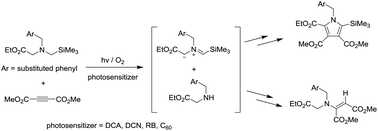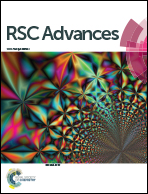Photoaddition reactions of N-benzylglycinates containing α-trimethylsilyl group with dimethyl acetylenedicarboxylate: competitive formation of pyrroles vs. β-enamino esters†
Abstract
A study was conducted to gain insight into the preparative potential of photosensitized reactions of acyclic N-benzylglycinates containing an α-trimethylsilyl group with dimethyl acetylenedicarboxylate (DMAD). The photosensitizers employed in the reactions include 9,10-dicyanoanthracene (DCA), 1,4-dicyanonaphthalene (DCN), rose bengal (RB) and fullerene C60. The results show that photoirradiation of oxygenated solutions containing the photosensitizers, glycinates and dimethyl acetylenedicarboxylate leads to competitive formation of pyrroles and β-enamino-esters. The distributions of pyrrole and β-enamino-ester products formed in these reactions are highly influenced by the electronic nature of the phenyl ring substituent on the benzylglycinates and the photosensitizer used. These photoaddition reactions take place via mechanistic pathways involving competitive formation of azomethine ylides and secondary amines, generated by a mechanistic routes involving initial SET from the benzylglycinates to photosensitizers.



 Please wait while we load your content...
Please wait while we load your content...